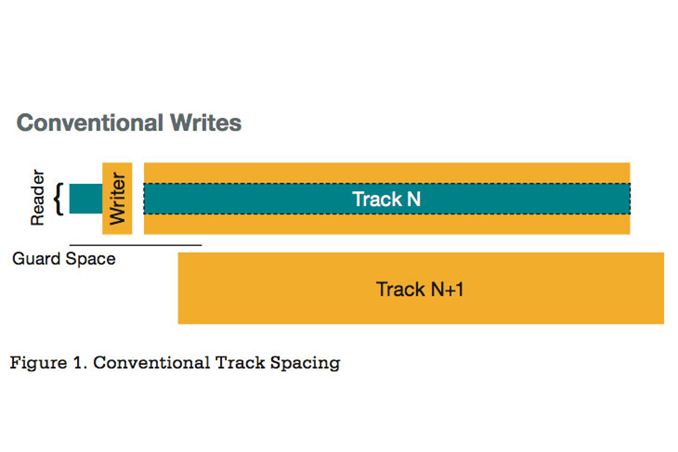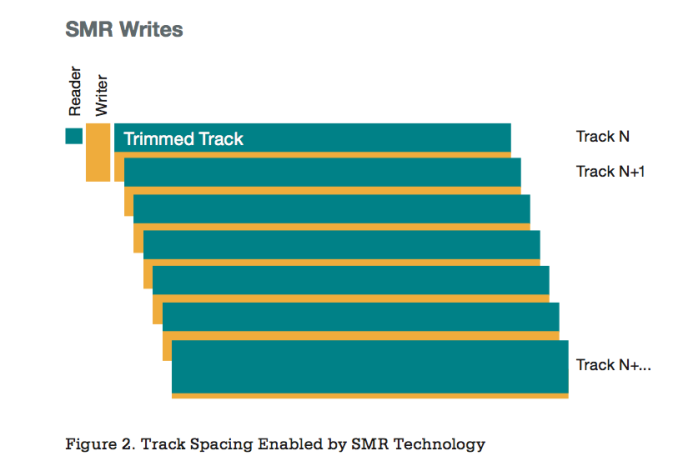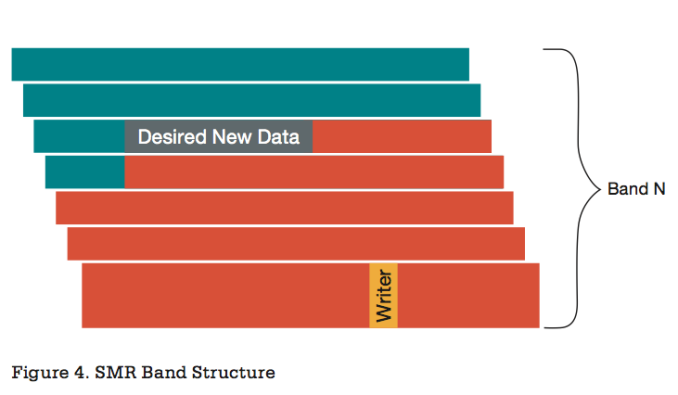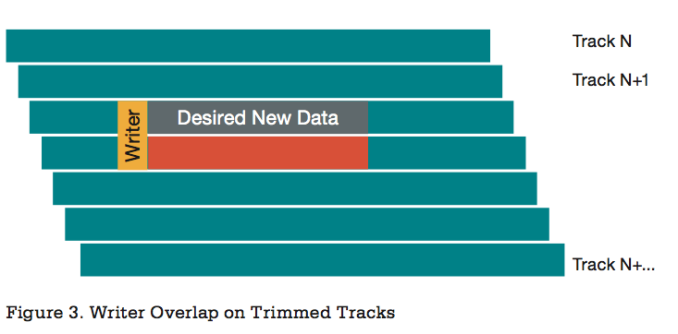Seagate to Ship 5TB HDD in 2014 using Shingled Magnetic Recording
by Anand Lal Shimpi on September 9, 2013 8:00 AM EST
It's not just planar NAND that's running into physical limits lately. According to Seagate, its latest 1TB platter 3.5" drives have shrunk read/write heads as small as they can physically go. Similarly, tracks on those platters are placed as close together as physically possible. Pushing areal density is important to increase overall capacities (no one wants to see more platters per drive), but if we're at physical limits today then it's time for some architectural changes to push capacities going forward.
Seagate's solution is something it calls Shingled Magneting Recording (SMR). The process is pretty simple. Track size is traditionally defined by the size of the write heads, as they are larger than the read heads. The track width is larger than necessary from the perspective of reading data back in order to decrease the chances of reading data from adjacent tracks. Seagate's SMR exploits this reality.
SMR shrinks the guard space between tracks and allows tracks to overlap one another, like roofing shingles. Although data is written to the entire width of the track, a smaller/trimmed portion of the track (the width of the read head) is all that the drive cares about. By allowing tracks to overlap, areal density can continue to scale without further shrinking the size of the heads.
The obvious downside of SMR is actually very NAND flash-like. When writing data sequentially to an empty platter, SMR is full of advantages. When you're writing to a series of tracks that already contains data, the SMR writing process is actually destructive. Since the writer remains full width and tracks now overlap, overwriting one track will actually harm the next track; those subsequent tracks will need to be overwritten as a result.
Seagate's SMR groups tracks into bands, with the end of each band breaking the shingled track layout. Breaking the shingled layout regularly reduces max attainable density, but it makes it so that overwriting a portion of one track doesn't force a re-write of the complete disk. At worst, overwriting some sectors will force a re-write of an entire band, not an entire platter.
Seagate claims it has already shipped 1 million SMR enabled drives (I didn't actually know any SMR drives had been shipping), but plans on using the technology to increase areal densities beginning next year. In 2014 Seagate will move from a 1TB per platter design to 1.25TB per platter thanks to SMR. The increase in platter density will allow Seagate to ship a 4 platter/5TB drive next year. Seagate is hoping to hit higher densities without any performance degradation compared to existing SMR designs. The real question is whether or not Seagate can maintain similar full drive performance compared to a non-SMR drive.













27 Comments
View All Comments
piroroadkill - Monday, September 9, 2013 - link
This seems dodgy, and the increase in density is not exactly mind blowing. Not too sure about this.name99 - Monday, September 9, 2013 - link
If you think this is "dodgy" then I'd advise you not to look at how HDDs have operated since at least 2000. Concepts like PRML and FEC will undoubtedly make you cry.(And you may want to also not look into how optical disks have ALWAYS operated, into how GigE operates [trellis coding to provide 6dB FEC gain], or how any wireless spec more recent than 802.11b operates.)
iwod - Monday, September 9, 2013 - link
My HDD is already fast enough for everything i intend it to do. Otherwise i have a SSD. And if SATA Express and PCI-Express 3.0 SSD could come faster the speed difference would be even greater.I want bigger HDD. Not 5TB but something more like 6TB by 2014. We haven't had much improvement in terms of capacity since the flood. I suspect the HDD makers are trying to milk the market as much as possible given their relatively low margin of profits.
Urizane - Tuesday, September 10, 2013 - link
I hope you realize that at 6TB you're asking for 48 trillion 1s and 0s. Perhaps an external enclosure with multiple drives would be more sensible, anyway. You would be better off protecting your data (RAID 5, 1+0, etc.) if you need that much of it. At that density, I wouldn't trust bits to be stable for very long (think quantum effects and so on).NetMage - Tuesday, September 10, 2013 - link
I wonder what happens if a power failure occurs at a bad time.jimdibb - Wednesday, November 27, 2013 - link
You really have to understand that these drives are not for your desktop. They are for archival, static storage. As used here http://www.theregister.co.uk/2013/11/26/facebook_d...Alientech - Friday, April 4, 2014 - link
Well they are already shipping. The write speeds are extremely slow and on par with USB2. Read speeds are the same pretty much. The Zones seem to be in a U shaped bit density where the edges have much higher density than the middle. The new ST3000DM001-1E6166 drives with the FC4x firmware have them. Not exacty sure how the writes work but they start off at 150MB with the cache empty and soon goes down to under 50MB after like 10GB or so of data. The speeds just dont make any sense and neither does the HDtune graphs with each zone showing a U shaped transfer rate. The last zone speeds drop down to around 80MB while on the older drives it was closer to 100MB. Average read speeds are down from 170MB to 150MB.